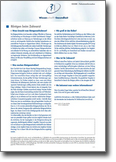Digital X-ray
Digital X-ray has become an integral part of the repertoire of modern dental examination methods. It makes it possible to visualize tooth and bone structures that otherwise could not be examined by the dentist. Digital X-ray is an imaging method in which, in contrast to conventional analog X-ray film, either a special digital memory plate or a digital sensor is exposed. Digital X-ray is a modern method that has several advantages over conventional X-rays.The images usually have a better quality than normal X-rays.
They can be edited directly on the computer and you can thus correct overexposed or underexposed shots and thus have to repeat fewer shots.
Digital X-ray thus saves time. The main advantage, however, is the lower radiation exposure, which is usually only 10% of the conventional radiation exposure.
The method is also more environmentally friendly because a digital X-ray image does not have to be developed. This means that the usual chemicals are no longer needed and do not have to be disposed of.
Digitization allows the X-ray image to be stored digitally without taking up much space.
Furthermore, images taken by digital X-ray can be quickly sent from computer to computer and, if necessary, assessed remotely.
For the patient, digital X-ray also means that he can look at the image directly at the treatment station and have it explained by the dentist.
Frequently asked questions about digital X-rays:
further information about digital X-ray
 |
|||||
